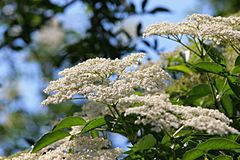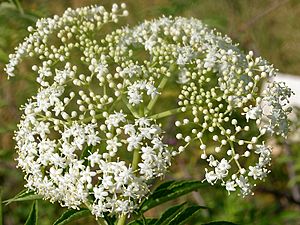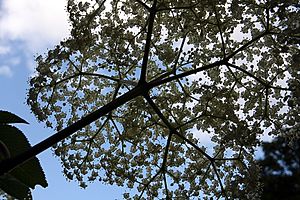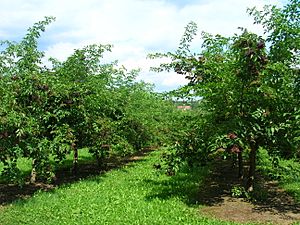Elderberry facts for kids
Quick facts for kids Elder or Elderberry |
|
|---|---|
 |
|
| Black Elder (Sambucus nigra) | |
| Scientific classification | |
| Kingdom: | |
| Division: | |
| Class: | |
| Order: | |
| Family: | |
| Genus: |
Sambucus
|

Elder or Elderberry is the name of a several similar types of shrubs. They produce fruit. The fruit is also called elderberries. Black Elderberry has been found to be effective against the H5N1 strain of Avian Flu.
Black Elderberries are rich in anthocyanins which are a type of flavonoid – anthocyanins are antioxidants that may protect cells from free radicals and support your body’s immune system.
Black Elderberries have almost 5 times as many anthocyanins as Blueberries and twice the overall antioxidant capability of cranberries Black Elderberry has a more potent antiviral effect than Echinacea. At sites in Switzerland and Italy, researchers have uncovered evidence that the black elderberry may have been cultivated by prehistoric man, and there are recipes for elderberry-based medications in the records dating as far back as Ancient Egypt. Historians, however, generally trace the tradition of the elderberry’s healing power back to Hippocrates, the ancient Greek known as the “father of medicine,” who described this plant as his “medicine chest” for the wide variety of ailments it seemed to cure.
Over the centuries, elderberry has been used to treat colds, flu, fever, burns, cuts, and more than 70 other maladies, from toothache to the plague.
Cultivation
Ornamental varieties of Sambucus are grown in gardens for their showy flowers, fruits and lacy foliage. Native species of elderberry are often planted by people wishing to support native butterfly and bird species.
Uses
Elderberry fruit or flowers are used as dietary supplements for minor diseases such as flu, colds, constipation, and other conditions, often served as a tea, extract, or in a capsule. There is insufficient research to know its effectiveness for such uses or its safety profile.
Nutrition
Raw elderberries are 80% water, 18% carbohydrates, and less than 1% each of protein and fat (table). In a 100 gram amount, elderberries supply 73 calories and are a rich source of vitamin C, providing 43% of the Daily Value (DV). Elderberries also have moderate contents of vitamin B6 (18% DV) and iron (12% DV), with no other nutrients in significant content (table).
Food
The French, Austrians and Central Europeans produce elderflower syrup, commonly made from an extract of elderflower blossoms, which is added to Palatschinken filling instead of blueberries. People throughout much of Central, Eastern, and Southeastern Europe use a similar method to make a syrup which is diluted with water and used as a drink or as a flavoring in several food products. In Germany, yoghurt desserts are made with both the berries and the flowers. Fruit pies and relishes are produced with berries. In Italy (especially in Piedmont), Germany and Austria, the umbels of the elderberry are batter coated, fried and then served as a dessert or a sweet lunch with a sugar and cinnamon topping, known as "Hollerküchel".
Every year, Romanians produce a traditional soft drink in May and June called "socată" or "suc de soc". It is produced by letting the flowers macerate with water, yeast and lemon for 2–3 days. The last stage of fermentation is done in a closed pressure proof bottle to produce a fizzy drink. The beverage has also inspired Coca-Cola to launch an elderflower-based drink, Fanta Shokata.
The flowers of Sambucus nigra are used to produce elderflower cordial. St-Germain, an American liqueur with faux-French branding, is made from elderflowers. Hallands Fläder, a Swedish akvavit, is flavoured with elderflowers. Despite the similarity in name, the Italian liqueur sambuca is mostly made with star anise and fennel essential oils extracted by vapor distillation. It also contains elderflower extracts with which it is flavored to add a floral note, to smooth and round off the strong licorice flavor.
Hollowed elderberry twigs have traditionally been used as spiles to tap maple trees for syrup.
Ecology
The berries are a very valuable food resource for many birds. In Northern California elderberries are a favorite food for migrating band-tailed pigeons. Flocks can strip an entire bush in less than an hour. Elders are used as food plants by the larvae of some Lepidoptera species including brown-tail, buff ermine, dot moth, emperor moth, engrailed moth, swallow-tailed moth and the V-pug. The crushed foliage and immature fruit have a strong fetid smell.
Valley elderberry longhorn beetles in California are very often found around red or blue elderberry bushes. Females lay their eggs on the bark. Larvae hatch and burrow into the stems.
Dead elder wood is the preferred habitat of the mushroom Auricularia auricula-judae, also known as "Jew's ear fungus".
The pith of elder has been used by watchmakers for cleaning tools before intricate work.
Habitat
Elder commonly grows near farms and homesteads. It is a nitrogen-dependent plant and thus is generally found near places of organic waste disposal. Elders are often grown as a hedgerow plant in Britain since they take very fast, can be bent into shape easily and grow quite profusely, thus having gained the reputation of being 'an instant hedge'. It is not generally affected by soil type or pH level and will virtually grow anywhere sufficient sunlight is available.
Images for kids
-
Dried elderberries ready for steeping
See also
 In Spanish: Sauco para niños
In Spanish: Sauco para niños






